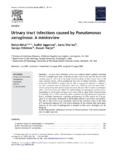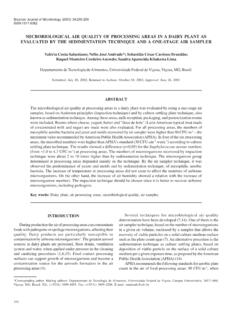Transcription of Journal of Food Engineering - Shafiur
1 food stability determination by macro micro region concept in the statediagram and by defining a critical temperatureMohammad Shafiur Rahman*Department of food Science and Nutrition, Sultan Qaboos University, Box 34, Al Khod 123, Omanarticle infoArticle history:Received 24 February 2009 Received in revised form 15 July 2009 Accepted 16 July 2009 Available online 21 July 2009 Keywords:Water activityGlass transitionIsothermFood stabilityFreezingDryingBakingMolecular mobilityabstractIn the 1950s the concept of water activity was proposed for determining food stability. This concept isnow being used although it has some limitations. Indeed, these limitations mean that the concept isnot universally applicable and in fact is invalid under certain conditions. In order to address the limita-tions of the water activity concept, the glass transition concept was proposed in the 1960s, although sig-nificant application of the concept only started in the 1980s.
2 Recently, it has become evident that theglass transition concept is also not universally valid for stability determination in all types of foods whenstored under different conditions. Currently in the literature the need is emphasized to combine thewater activity and glass transition concepts since both concepts could complement each other. The glasstransition concept was used to develop the state diagram by drawing another stability map using freezingcurve and glass transition line. In this paper an attempt is made to review the published methods used tocombine both concepts. These approaches are graphical plot of glass transition conditions and water con-tent as a function of water activity, and macro micro region concept in the state diagram. In addition, anew approach is proposed in this paper by defining a critical temperature for stability and then relating itwith water content, and other hurdles affecting food stability.
3 The water mobility concept is alsoreviewed to provide another dimension of food stability in order to determine a more complete picture. 2009 Elsevier Ltd. All rights IntroductionFood preservation involves the action taken to maintain the de-sired properties or nature of foods, within a time frame, so that itremains safe and pleasant to consume. A stable food product canbe developed by applying different processing techniques and bykeeping it in appropriate conditions. food stability determinationfrom a scientific basis rather than empiricism is a challenge to foodscientists and engineers. A relatively complete coverage of foodpreservation is available in the Handbook of food Preservationand other references (Rahman, 2007a; Kalichevsky-Dong, 2000).Microbial death/growth and deteriorative physical, chemical andbiochemical changes during processing and storage depend onmany factors, such as water content, food composition, preserva-tives, pH, and environmental or processing factors (temperature,pressure, electricity, gases or vapors).
4 A list of hurdles for increas-ing food stability is included inTable 1. A significant proportion ofthe food products on the supermarket shelf are preserved based onthe main hurdle being pH, water activity, low temperature (freez-ing and refrigeration) or heat treatment (pasteurization and steril-ization). In addition other hurdles are imposed in combinations,such as including spices and the 1950s the concept of water activity was proposed todetermine the stability of foods and in the 1980s significant dataon food stability as a function of water activity was published. Toavoid the limitations of the water activity concept, the glass tran-sition concept was extensively applied in the 1980s although theconcept had initially appeared in the literature much earlier inthe 1960s. The stability of foods is of the up most importance toboth food scientists and engineers; and a better understanding ofthe factors controlling stability or reactions rates is clearly needed(Le Meste et al.)
5 , 1997; Kalichevsky-Dong, 2000; Rahman, 2006). Inthis paper the concepts of water activity and glass transition aresummarized and their applications and limitations identified. Amacro micro region concept combining water activity and glasstransition concepts in the state diagram was first presented inthe 18th International Congress of Chemical and Process Engineer-ing (CHISA 2008), 24 28 August 2008, Prague, Czech Republic, andwas subsequently published in the International Journal of FoodProperties (Rahman, 2009). In this current paper an attempt ismade to further explain the macro micro region concept and topresent its applications in food processing as well as in determin-ing food stability during storage. In addition, a new approach isproposed by defining a critical temperature for stability, which0260-8774/$ - see front matter 2009 Elsevier Ltd.
6 All rights *Tel.: +968 2414 1273; fax: +968 2441 of food Engineering 99 (2010) 402 416 Contents lists available atScienceDirectJournal of food Engineeringjournal homepage: be further related with water content and other hurdles infood Water activity conceptIn the 1950s scientists began to discover the existence of a rela-tionship between the water contained in a food and its relative ten-dency to spoil (Scott, 1953). It was observed that the active watercould be much more important to the stability of a food than thetotal amount of water present. Thus, it is possible to develop gen-eralized rules or limits for the stability of foods using water activ-ity. For example, there is a critical water activity level below whichno microorganisms can grow. Pathogenic bacteria cannot grow be-low a water activity of , whereas yeasts and molds are moretolerant to reduced water activity, but usually no growth occursbelow a water activity of about It has been widely recognizedthat the concept of water activity has been accepted as a valuabletool for determining microbial stability (Chirife and Buera, 1996).
7 Acomplete discussion on the microbial response to low water activ-ity was presented byRahman (2009).A food product is the most stable at its monolayer moisture content, which varies with the chemical composition, structureand environmental conditions, such as temperature. The BET-monolayer value can be determined from the well known BET-equation. The BET-monolayer estimation is an effective methodfor estimating the amount of water molecules bound to specific po-lar sites in a food matrix and it does not simply apply to the prod-uct surface. A more detailed explanation of the BET-monolayer,including their estimation and validity was recently provided byRahman and Al-Belushi (2006). In general the rule of water activityconcept is: food products are most stable at their BET-monolayermoisture content or BET-monolayer water activity and unstableabove or below BET-monolayer.
8 However, experimental evidenceshowed that optimal moisture for stability was in the multilayeradsorption region (Caurie, 1971a, b). In many other instances ithas been shown that optimal water content for stability is not ex-actly the BET-monolayer. The reason for this variation is due to thefact that the BET theory of adsorption was developed based onmany simplified assumptions, which are not realistic when foodis of the earlier food stability maps based on the water activ-ity concepts contained growth of micro-organisms and differenttypes of bio-chemical reactions (Labuza et al., 1972). The updatedfood stability map based on the water activity is presented inFig. 1(Rahman, 2009). In this present map, the trends of microbialgrowth, bio-chemical reactions and mechanical characteristicsare presented in the three zones of water activity.
9 This stabilitymap indicates that different types of dynamics in reaction ratescan happen as a function of water activity. An example is shownin Fig. 2using the process of non-enzymatic browning. This figureillustrates the non-enzymatic browning rate at 70 C in a gelati-nized starch medium as a function of water activity and moisturecontent (Acevedo et al., 2008). The figure shows that the reactionrate increased with increasing water activity up to the BET-mono-layer ( reached a peak) followed by a decrease in the reactionrate with further increases in water activity. In this example, thematrix is most stable below the BET-monolayer as expected; andabove BET-monolayer, reaction rate decreased instead of showingan increasing trend ( stability increased at least for non-enzy-matic browning). However, this could be explained due to the dilu-tion effect of solvent water at higher moisture.
10 However, thepurpose of this example is not to overemphasize the BET-mono-layer or to draw conclusions concerning non-enzymatic browning,but rather to present an example of a food stability map includingthe limitations of the water activity concept are identified as(Rahman and Labuza, 2007; Rahman, 2005, 2006; Chirife, 1994;NomenclatureGmodulus (Pa)krate constant (day 1)mfragility parameterNMR Nuclear Magnetic ResonanceTtemperature ( C or K) or NMR signalXmass fraction (g/g sample)Greek symbolahigh-density regionblow-density regionSubscriptbBET-monolayer waterccritical (where change in slope)gglass transitiongsglass transition solidsgwglass transition watermmelting point of ice ( freezing point)msmelting point of solidsssolidsueutectic pointwwater2rate constant for decay of peroxide value inkSuperscript0maximal-freeze concentration condition inX.)






